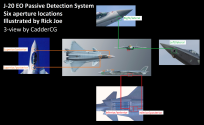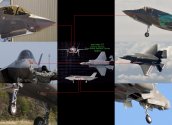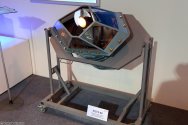@tphuang did they mention anything regarding to the capabilities of EOTS-86 vs F35's EOTS? i've always thought it was less capable than F35's because there doesn't seem to be bottom or rear facing windows on EOTS-86 to provide full ground coverage.
J-20 does not use "EOTS-86" to the best of our knowledge.
It uses a faceted chin mounted EO IRST system, but its designation is not one we know. However we know it does not look the same as the "EOTS-86" system as seen from the company that advertised it ("Beijing A-Star"), and frankly I've long held doubts as to how serious the product catalogue promoted by Beijing A-Star actually was.
You are correct that the J-20's chin mounted EO IRST system appears to have an opaque rear aspect, whereas the F-35's AAQ-40 EOTS has a continuous rear aspect all around the faceted mount. This makes sense because the F-35's AAQ-40 EOTS is designed to operate as an air to ground sensor as well (and with the ability to monitor and laser designate ground based targets), in a way as close as possible to traditional targeting pods, which requires a 360 degree gimbal capability.
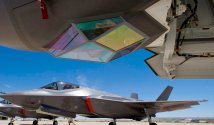
J-20's chin mounted EO IRST appears to primarily be an air to air sensor, which similar to the mounting for the AIRST system proposed for F-22, has an opaque rear aspect, which is consistent with a sensor more prioritized for the forward and side aspects most important for the air to air misison.
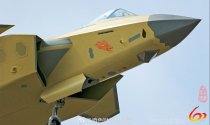
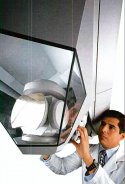
What are you talking about? of couse J-20 has race window of EOTS, just unlike EOTS in F-35 which is a rotate camero system under its nose, so everything is intergrate in one block, J-20 has two seperate EOTS system in its belly and its back to look in the front/back upper/lower sphare.
His post wasn't very clear, but he was talking about the chin mounted EO IRST sensor on J-20, compared with the chin mounted AAQ-40 EOTS sensor on F-35.
Those are mechanically gimbaled, relatively large aperture sensors that can be re-oriented within its housing for a target.
What you are talking about as "two separate EOTS system in its belly" is part of the J-20's 360 degree electro optic passive detection system (six fixed, non moving, relatively small aperture sensors, that operates at minimum like an advanced MAWS, but may also operate like an EODAS system).
However, F-35 has such a system (AN/AAQ-37 EO DAS) as well, with six fixed, non moving, relatively small aperture sensors, which we know can provide advanced passive tracking and "see through the cockpit" capability, as well as an advanced MAWS capability.
These fixed, six small aperture systems on J-20 and F-35 complement, but do not replace the chin mounted, mechanically rotated, large aperture sensors on the noses -- and it is correct to say that F-35 possesses a key capability which J-20 doesn't, which is that the F-35 can rotate its chin mounted sensor all the way 360 degrees whereas J-20's chin mounted sensor looks like it is unable to see the rear 90 degrees aspect.
However, that probably isn't very important, because J-20's chin mounted sensor looks like it is most optimized for an air to air mission where the forward aspect sensing capability is most important, whereas F-35's chin mounted sensor also serves an air to ground role where 360 degree rotation is more important.
